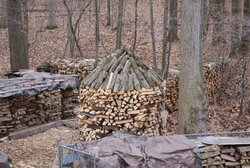Hi all,
Getting ready for my first season. Unfortunately, I'm not going to be using truly seasoned wood this year. My supply is almost entirely log-length wood that sat on the ground for 1-3 years and is only being split as of September (I'll start burning in November). I'm giving it plenty of air in the stacking in the hopes it seasons faster.
Anyway, so far my stacks are unprotected from the elements. They are getting lots of rain. I understand there is no general consensus on whether or not this helps/hinders wood seasoning, but what I'm wondering is: How long does it typically take to dry wood once it's been rained on prior to burning it? For example: worst-case scenario would be it'd be in dry-air 45 degrees ambient.
In the future, I'll be tarping it or similarly covering the top. For now, I'm just wondering how much of a pain in the arse this makes it.
Thanks and I did search for this. However, searching on this forum for stuff like "Wood/dry/rain/how long" is like trying to find a needle in a 6-cord wood stack.
Joe
Getting ready for my first season. Unfortunately, I'm not going to be using truly seasoned wood this year. My supply is almost entirely log-length wood that sat on the ground for 1-3 years and is only being split as of September (I'll start burning in November). I'm giving it plenty of air in the stacking in the hopes it seasons faster.
Anyway, so far my stacks are unprotected from the elements. They are getting lots of rain. I understand there is no general consensus on whether or not this helps/hinders wood seasoning, but what I'm wondering is: How long does it typically take to dry wood once it's been rained on prior to burning it? For example: worst-case scenario would be it'd be in dry-air 45 degrees ambient.
In the future, I'll be tarping it or similarly covering the top. For now, I'm just wondering how much of a pain in the arse this makes it.
Thanks and I did search for this. However, searching on this forum for stuff like "Wood/dry/rain/how long" is like trying to find a needle in a 6-cord wood stack.
Joe



